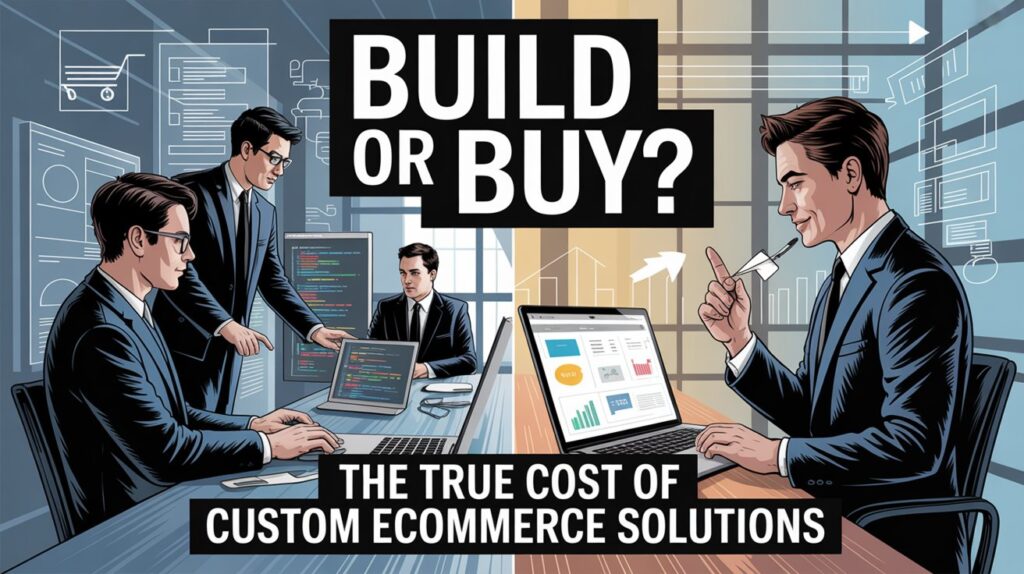Off-the-shelf platforms often limit growth due to rigid workflows and poor scalability, especially in B2B environments. To overcome these constraints, businesses are turning to custom ecommerce solutions for businesses and investing in custom B2B ecommerce solutions that support advanced integration, automation, and user experience design. These ecommerce custom solutions offer the adaptability needed in a market where 80% of B2B transactions are expected to be digital by 2025.
Building In-House: Pros, Cons, and Cost Drivers
Choosing to develop custom ecommerce solutions in-house gives businesses full control over platform structure, functionality, and user experience. It enables precise alignment with internal workflows, advanced integrations, and the ability to implement unique branding and design.
However, this path comes with significant challenges. Internal builds often require large development teams, high upfront investment, and long delivery timelines. Businesses must also manage ongoing updates, scalability concerns, and security responsibilities on their own.
For companies with experienced technical teams and clearly defined long-term goals, building in-house can result in a competitive edge. But for those lacking sufficient internal capacity or looking to move fast, the time and cost involved may outweigh the potential benefits of complete customization.
Buying or Partnering: When Prebuilt Isn’t Enough
Many organizations begin with off-the-shelf ecommerce platforms for speed and ease. Yet as complexity grows—especially around integrations, workflows, or compliance—standard tools often fall short. That’s when companies turn to custom ecommerce development solutions via tech partners or consulting firms. Working with experts like the agentic ai company enables rapid deployment of tailored features that align closely with your business model.
Industry data shows custom ecommerce projects range from $50,000 to $300,000+, depending on scope and scale (Lizard Global). These ecommerce custom solutions offer faster time-to-market and expert support, minimizing hidden costs of in-house builds. When your requirements exceed generic platform capabilities—but you’re not ready to embark on a full build—partnering can offer the perfect balance of speed, quality, and flexibility.
Custom Ecommerce Website Solutions: UX, Speed, and SEO Advantages
In ecommerce, speed, usability, and visibility directly impact conversions. A slow site can cost you sales — and generic themes rarely offer the optimization needed to stay competitive.
With custom ecommerce website solutions, brands can fine-tune performance, enhance UX, and build SEO-friendly structures from the ground up. These setups support schema markup, fast load times, and responsive design.
Unlike rigid templates, ecommerce custom solutions adapt to your unique goals — making your site faster, more visible, and more engaging.
Custom Ecommerce Website Solutions: UX, Speed, and SEO Advantages
Why tailored platforms outperform templates
Modern ecommerce success depends on more than just products — it’s about how fast your site loads, how easily it ranks, and how engaging it feels. That’s where custom ecommerce website solutions give brands a measurable edge.
Key advantages include:
- Faster load times
- Clean, optimized codebase
- No unnecessary plugins or bloated themes
- Built-in lazy loading and compression strategies
- Better SEO performance
- Custom URL structures and clean metadata
- Schema markup for rich search results
- Lightning-fast Core Web Vitals compliance
- Superior UX and UI
- Custom navigation flows for specific customer journeys
- Optimized checkout with fewer steps
- Fully responsive designs tailored to your audience
Unlike pre-built themes, custom ecommerce website solutions are built around your strategy — not someone else’s idea of what ecommerce should look like. This means better rankings, smoother experiences, and more conversions.
H2: Total Cost of Ownership: Building vs. Buying Over Time
Choosing between building and buying isn’t just about upfront costs — it’s about long-term value, scalability, and the true cost of ownership. Businesses must assess not only what they spend today, but what they’ll continue spending over time.
Total Cost Comparison: Build vs. Buy
| Cost Factor | Build In-House | Buy/Partner with Tech Vendor |
| Initial Investment | $500K–$1.2M for full custom platform | $50K–$300K for tailored solution |
| Time to Launch | 9–18 months | 3–6 months |
| Maintenance Costs | Ongoing developer salaries + server costs | Vendor support fees or retainer |
| Scalability | Fully flexible but resource-intensive to scale | Scalable based on vendor stack capabilities |
| Upgrades | Custom, often manual | Regular vendor-provided updates and patches |
| Risk Exposure | Higher (technical debt, hiring risk, delays) | Lower (shared risk with partner/vendor) |
While custom ecommerce solutions built in-house offer unmatched flexibility, they come with heavier operational burdens. Buying or partnering delivers faster returns, smoother upgrades, and predictable costs — ideal for businesses prioritizing speed and agility.
Making the Right Choice for Your Business
There’s no one-size-fits-all answer. Choosing to build, buy, or partner depends on your internal capabilities, timeline, and strategic priorities.
- Build if you have a seasoned tech team, long-term funding, and need complete platform control.
- Buy if you seek fast deployment, have standard use cases, and want predictable costs.
- Partner if you need tailored functionality but lack internal bandwidth.
Team maturity, budget constraints, and time-to-market goals all matter. Long-term success depends on how well your ecommerce infrastructure aligns with business objectives — not just today, but two or five years ahead. Think beyond the platform — think ecosystem.
Conclusion — Custom Doesn’t Mean Complicated
Investing in custom ecommerce solutions doesn’t have to mean starting from zero. With the right tech partner, businesses can launch scalable, tailored platforms without sacrificing speed or performance.
Custom doesn’t mean bloated or slow — it means purpose-built. When done right, it supports growth, differentiation, and operational efficiency. Now is the time to evaluate your platform critically. If it’s holding you back, it may be time to shift toward a smarter, future-ready solution that grows with you.

